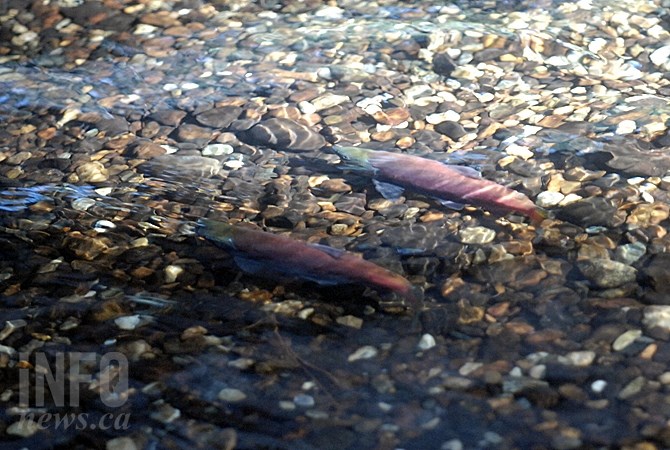
(ADAM PROSKIW / iNFOnews.ca)
October 21, 2015 - 9:00 PM
OKANAGAN - It’s a record year for Kokanee salmon spawning on Okanagan Lake.
Jason Webster, a Vernon-based fisheries biologist, says more than 300,000 shore spawners were counted during this year’s annual survey — the most in more than 25 years.
“It’s turning into a cyclical thing where every four years there’s a great big run, but this year has really been exceptional,” he says.
Looking back over that cyclical period, 2007 and 2011 were both big years, with about 240,000 and 280,000 Kokanee counted respectively.
“Hitting the 300,000 is pretty exciting,” Webster says. “We haven’t seen numbers like that since the early 1970s.”
He suspects the biggest factor in the Kokanee’s resurgence has to do with a change in how Okanagan Lake is drained every year. Previously, the lake was lowered after the salmon spawned, which led to the eggs drying out and dying when the water level receded.
“Now they lower the lake as much as they can prior to spawning,” Webster says. “They’ve changed the way they do the draw down, and surprise, surprise, the shore spawning Kokanee have exploded.”
Kokanee salmon fishing isn’t as popular as it used to be, Webster says, because fishermen are generally more interested in catching bigger fish. The Kokanees in Okanagan lake don’t get much bigger than 25 centimetres, but they are an important food source for larger and more sought after fish — and that's good news for fishermen.
“What they translate into is feed for the rainbow trout, the big fish everybody is after. They’re the number one food source for trout,” Webster says.
Through fishing surveys and word of mouth, Webster says it’s pretty common knowledge that rainbow trout haven’t been doing very well — at least until this year.
“This season, people have said it’s coming back, and that’s probably because we had 300,000 of these Kokanee shore spawners,” Webster says.
Webster also researches another type of Kokanee salmon that spawns in creeks around the Okanagan, and unfortunately, that fish is experiencing a different trend.
“They’ve gone down further and further where it’s now about ten per cent of the original population. It’s just terrible,” Webster says.
He believes man-made changes to creek beds is one of the biggest reasons the salmon are struggling.
“Creeks are naturally supposed to meander back and forth with pools, now they’re all dyked. There’s not much in the way of variation like a stream should have,” he says.
He notes some work has been done to return creeks to their natural states, such as the Mission Creek project in Kelowna. That initiative began in 2004 to setback the dykes along the creek.
To contact the reporter for this story, email Charlotte Helston at chelston@infonews.ca or call 250-309-5230. To contact the editor, email mjones@infonews.ca or call 250-718-2724.
News from © iNFOnews, 2015